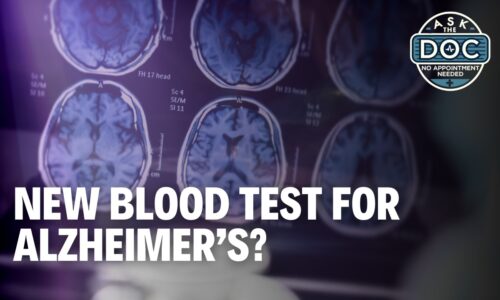Eating Disorders with Dr. Melissa Spann |
Anorexia, bulimia, and binge eating are the three different types of eating disorders.
Dr. Melissa Spann, Psychotherapist and Executive Director with Oliver-Pyatt Centers, explains each one and talks about the most common one.
Transcript
Now when it comes to eating disorders there are three different types we’ve talked about them in the past there is anorexia bulimia and binge eating yes which is the most common actually binge eating disorder is the most common of all three eating disorders there are binge eating disorder is three times most likely to occur anorexia nervosa is really classified as an inability to gain weight a low body weight and a preoccupation with size and body and bulimia nervosa is identified as recurring episodes of binge and purging episodes so binging is eating a large amount of food in a specific period of time and a purging has to do with a compensatory behavior so that might be something like self induced vomiting it could also be something like the use of laxatives diuretics or even compulsive exercise which is something people don’t often think about are there other types besides those three I know those three are the most prevalent yeah there there are other types of eating disorders there is pica which is eating things that aren’t really food someone who’s eating paper paper paper yes it’s a that’s a whole different talk although come back and do that another time with you yeah Wow and then other eating disorders including are fed and us fed so us that is an eating disorder diagnosis that stands for other specified feeding disorders so it’s when someone doesn’t meet the clinical diagnostic criteria for anorexia or bulimia or binge eating disorder but still needs has clinically significant impairment and binge eating disorder only became an official diagnosis in 2013 with the new Diagnostic and Statistical Manual you
Anorexia, bulimia, and binge eating are the three different types of eating disorders.
Dr. Melissa Spann, Psychotherapist and Executive Director with Oliver-Pyatt Centers, explains each one and talks about the most common one.
Transcript
Now when it comes to eating disorders there are three different types we’ve talked about them in the past there is anorexia bulimia and binge eating yes which is the most common actually binge eating disorder is the most common of all three eating disorders there are binge eating disorder is three times most likely to occur anorexia nervosa is really classified as an inability to gain weight a low body weight and a preoccupation with size and body and bulimia nervosa is identified as recurring episodes of binge and purging episodes so binging is eating a large amount of food in a specific period of time and a purging has to do with a compensatory behavior so that might be something like self induced vomiting it could also be something like the use of laxatives diuretics or even compulsive exercise which is something people don’t often think about are there other types besides those three I know those three are the most prevalent yeah there there are other types of eating disorders there is pica which is eating things that aren’t really food someone who’s eating paper paper paper yes it’s a that’s a whole different talk although come back and do that another time with you yeah Wow and then other eating disorders including are fed and us fed so us that is an eating disorder diagnosis that stands for other specified feeding disorders so it’s when someone doesn’t meet the clinical diagnostic criteria for anorexia or bulimia or binge eating disorder but still needs has clinically significant impairment and binge eating disorder only became an official diagnosis in 2013 with the new Diagnostic and Statistical Manual you
Anorexia, bulimia, and binge eating are the three different types of eating disorders.
Dr. Melissa Spann, Psychotherapist and Executive Director with Oliver-Pyatt Centers, explains each one and talks about the most common one.
Transcript
Now when it comes to eating disorders there are three different types we’ve talked about them in the past there is anorexia bulimia and binge eating yes which is the most common actually binge eating disorder is the most common of all three eating disorders there are binge eating disorder is three times most likely to occur anorexia nervosa is really classified as an inability to gain weight a low body weight and a preoccupation with size and body and bulimia nervosa is identified as recurring episodes of binge and purging episodes so binging is eating a large amount of food in a specific period of time and a purging has to do with a compensatory behavior so that might be something like self induced vomiting it could also be something like the use of laxatives diuretics or even compulsive exercise which is something people don’t often think about are there other types besides those three I know those three are the most prevalent yeah there there are other types of eating disorders there is pica which is eating things that aren’t really food someone who’s eating paper paper paper yes it’s a that’s a whole different talk although come back and do that another time with you yeah Wow and then other eating disorders including are fed and us fed so us that is an eating disorder diagnosis that stands for other specified feeding disorders so it’s when someone doesn’t meet the clinical diagnostic criteria for anorexia or bulimia or binge eating disorder but still needs has clinically significant impairment and binge eating disorder only became an official diagnosis in 2013 with the new Diagnostic and Statistical Manual you
Anorexia, bulimia, and binge eating are the three different types of eating disorders.
Dr. Melissa Spann, Psychotherapist and Executive Director with Oliver-Pyatt Centers, explains each one and talks about the most common one.
Transcript
Now when it comes to eating disorders there are three different types we’ve talked about them in the past there is anorexia bulimia and binge eating yes which is the most common actually binge eating disorder is the most common of all three eating disorders there are binge eating disorder is three times most likely to occur anorexia nervosa is really classified as an inability to gain weight a low body weight and a preoccupation with size and body and bulimia nervosa is identified as recurring episodes of binge and purging episodes so binging is eating a large amount of food in a specific period of time and a purging has to do with a compensatory behavior so that might be something like self induced vomiting it could also be something like the use of laxatives diuretics or even compulsive exercise which is something people don’t often think about are there other types besides those three I know those three are the most prevalent yeah there there are other types of eating disorders there is pica which is eating things that aren’t really food someone who’s eating paper paper paper yes it’s a that’s a whole different talk although come back and do that another time with you yeah Wow and then other eating disorders including are fed and us fed so us that is an eating disorder diagnosis that stands for other specified feeding disorders so it’s when someone doesn’t meet the clinical diagnostic criteria for anorexia or bulimia or binge eating disorder but still needs has clinically significant impairment and binge eating disorder only became an official diagnosis in 2013 with the new Diagnostic and Statistical Manual you








